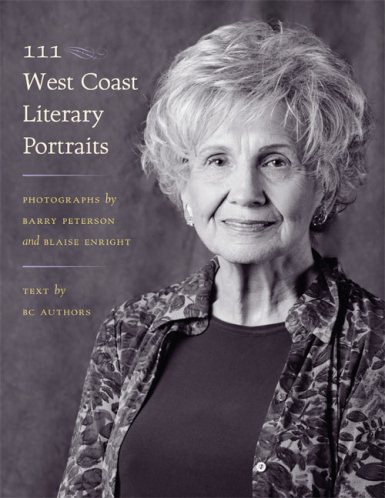If a picture’s worth a thousand words, 111 West Coast Literary Portraits is invaluable. Fifteen years in the making, it contains more than 100 photographs of B.C. authors, as well as extracts from their work or personal notes written specifically for the book.
 The book is an important documentary of B.C. literature. It includes emerging, famous, as well as infamous authors and speaks to the diversity of literature, culture and the unique voice of Canada’s most western province. A work of art in its own right, the 8 x 10 heavy stock, glossy paper gives a depth and luminosity to each portrait. And the use of black and white film provides a classic, timeless quality to the images.
The book is an important documentary of B.C. literature. It includes emerging, famous, as well as infamous authors and speaks to the diversity of literature, culture and the unique voice of Canada’s most western province. A work of art in its own right, the 8 x 10 heavy stock, glossy paper gives a depth and luminosity to each portrait. And the use of black and white film provides a classic, timeless quality to the images.
When Barry began photographing writers he didn’t realize he was starting a book project. He and his wife at the time, Blaise Enright, were new to the West Coast and wanted a project they could work on together while exploring their new environment. By a quirk of fate, authors became the focal point. But it wasn’t always easy.
R.W. Gray wanted to be photographed partially submerged in water. Rick and I wanted to include our dog but Bailey thought posing meant running around in circles. Stephen Reid wanted to wear a cop costume and have a gun and some money on the table in front of him. Little did Barry and Blaise know that Reid’s props would later be used in a real life drama.
But perhaps the most difficult photo shoot was of poet Al Purdy. The initial images didn’t turn out well. Soon after Purdy received the proofs Barry answered the phone to find someone screaming at him. Purdy, a character with an occasional crusty edge, demanded the photos be retaken the next day or he’d black list the photographers with every writer in B.C.
It was a scramble for Barry and Blaise to get to Victoria from Vancouver on time but they made it. Along the way, Blaise bought an assortment of squeaky toys hoping to lighten up the situation. After the shoot, Purdy said he hadn’t known whether to smile or be offended. The photo on page 158 tells it all.
As the collection of photographs grew, it was titled Lit Happens and exhibited in a variety of venues to promote literacy in B.C. A couple of years ago, Mona Fertig of Mother Tongue Publishing approached Barry about turning the photographs and accompanying text by authors into a book.
This fall, Barry has exhibited prints from the book, attended signings and participated on panels of photographers throughout the Lower Mainland, Vancouver Island and Gulf Islands. 
Barry’s always been passionate about black and white film. “It helps the viewer focus on the subject,” he explains. “There’s no confusing palette of colours and it seems to really highlight the subject. Also, film photographs have a depth to them that digital can’t duplicate.” As well as taking the photographs, Barry developed all the film, matted and framed the prints and even made the cardboard boxes to transport them in.
Through 2009 and 2010, Barry and I collaborated on a photo-journalism project called On the Edge, Putting a Face on Homelessness. Time and time again, I witnessed Barry’s easy-going manner help nervous folks relax, watched him guide people into natural-looking poses and admired the meticulous detail that went into the printing of film and framing of photo and text.
He’s brought the same attention to detail to 111 West Coast Literary Portraits. For more information visit www.barrypetersonphotography.com or www.mothertonguepublishing.com.
